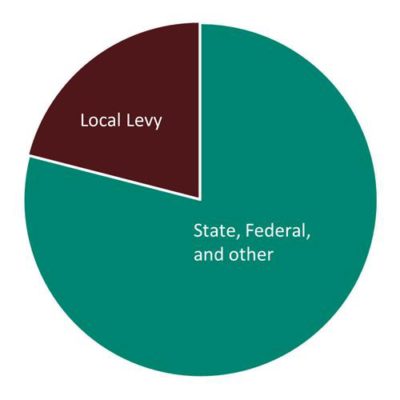There’s an old saying “money won’t solve problems” but usually that’s said by someone who owns a house, has a car, and isn’t worried about Maslow’s hierarchy of needs. Washington State isn’t the worse at funding public education but it’s not part of the top ten in the country.
Needless to say, if the Washington State Legislature was fully funding education, we wouldn’t be in the midst of a lawsuit (see McCleary breakdown).
The recently released Senate Republican’s bill SB 5607 tries to address concerns about funding education by including a brief discussion of levies and an extensive description of weighted per pupil funding. I am not an expert in these matters but I think it’s important for all educators to try to engage with these issues.
A little bit of context:
First, in order to think about school funding it’s necessary to realize that levies are a significant factor. As Highline Public Schools explains it, “Levies are for learning. Bonds are for building.”  Thus, levies include everything from staffing (teachers, instructional aids, nurses, librarians, etc.) to supplies like books, computer upgrades, athletics, and arts, depending on what a district has rolled into its levy. It is all this “stuff” that is usually used to calculate what a district pays out in their per pupil costs (have you seen this incredible map?!).
Thus, levies include everything from staffing (teachers, instructional aids, nurses, librarians, etc.) to supplies like books, computer upgrades, athletics, and arts, depending on what a district has rolled into its levy. It is all this “stuff” that is usually used to calculate what a district pays out in their per pupil costs (have you seen this incredible map?!).
Hypothetically, a district’s funding looks something like this pie chart, but every district has a unique set of concerns exacerbated by its location (urban, rural, suburban), its economic stability (employment rates, etc.), and the needs of its students. Thus, some districts rely on roughly 20% of their budget coming from levies while others might rely on as much as 25%.
Second, when we say “per pupil expenditures” we basically mean how much money it “costs” to educate this child. This can include a gamut of things and–from what I understand–might include a portion of a teacher’s salary or costs for programs to mitigate special needs.
I took a dive into Part I: Weighted per Pupil Funding Model of SB 5607 and when I came up for air here are a few of the things that stood out to me. I figure a pros/cons list is one of the easiest ways to address this.
The Pros: A stated focus on equity.
- In the setup of the case for equity is laid out explicitly. “The legislature further finds that the current system unfairly drives more money to wealthier districts, on a per pupil basis, for low-income, special education, and transitional bilingual students than to poor districts.” I appreciate this because while most classroom teachers understand inequity in education funding, it often seems like those who inform education policy do not.
- The term “equity” and “inequities” are weaved throughout the document. This again stands out to me because often in education so much of this system is set around standards of fairness and equality when in fact we need equity. Some school districts or schools within a district need different allocations of funds so that students can be served.
- As someone who teachers AP Language and Composition, word choice matters. I love that the stated objectives of this section of the budget is to provide ampleness, dependability, equity, and transparency.
The Cons: A heap of unanswered but important questions.
- While the objectives are clearly stated, as I read through the budget I continue to ask myself is this budget really ample, dependable, equitable, and transparent? At times the numbers don’t seem to add up.
- Where are the additional dollars for schools coming from? This isn’t clearly outlined.
- How will districts and schools be held accountable for new money, including what are the accountability measures for ensuring money is spent where it is supposed to be?
- Since it seems we are creating a new system, how will district personnel be trained in the new system?
- Since the Senate budget calls for additional funding for special populations of students (ex. ELL, Special Education) can students be counted more than once? For example, will a student be counted as ELL + Poverty + Highly Capable? Is this in-line with the objectives of ample, dependable, equitable, and transparent?
- Are there other special populations (no mention of foster kids anywhere) that are missing or will they be added later–if so, when and by whom?
- What about equity within a school district? If the money goes to the district, but say most of the students with “additional funds” attend one or two schools, how will it be ensured that the money will follow them to that specific school?
There is much to consider in this budget proposal. I encourage you to do your own research, pose more questions for us to ponder, and read this clear, succinct analysis of SB 5607 released by the Equity in Education Coalition last week.

Well I have a huge concern with schools placing non spanish kids in English Learners and never informing the parent. Kindergarden through sixth grade I have always attended conferences, meetings, school activities, picnics, and not once was I ever informed that my child was involved with this program. It wasnt till we moved to another district where my son would come home upset that he was seperated from his other class mates to work with English Learners. I called the school teachers and because his STAR TEST score were not up to state guidelines. He was stuck in the program till he was assessed by the program. Ok well where are his previous testings? I would like to see how he was assessed and why was I not notified? Infact every test the school gave him was signed by teachers and principle, but nothing by me. My son tells me that 85% of the kids in his class all were born in the US and do not speak a word of spanish. This is discrimination towards my son and many other hispanic kids at his school. Are schools placing kids in English Learner classes just for funding? My son is hispanic and being in English Learners can affect his whole future. He is an American Citizen who deserves the same English only education he deserves. Now that I finally rustled him out of the program which was not easy, he has to work twice as hard! Can someone help tutor him one on one? He has to catch up. Its not fair and shame on Conejo Valley Glennwood school for trying to save their jobs and school closures at the expense of our children. Shame shame shame. I wish I could do something to help others like Jacob, but I wouldnt even know where to begin. Thank u for allowing me to share my story. God bless. Silvia 🙂
I can’t help but feel as if this budget is the Senate’s way of absolving themselves from McCleary and putting it all on the districts to manage. So when this comes crashing down on public ed the Senate can assert that it was the districts’ lack of resource management that caused teachers to flee the state or quit the profession.
Is this budget ample, dependable, equitable and transparent? That’s the question.
My leaning is that no, it isn’t ample: the analyses I’ve read bring up that there isn’t a clear “sum total” of what the bill would cost… as if we’ve been led to focus on the per-pupil structure in order to prevent us from seeing that the total will end up being less (statewide).
Dependable? A cool maybe. At least there’s a description of the revenue source (1.80/1000), but is that the right source?
Equitable: It pretends to be but my gut says that once put into practice, it will not address cross-state inequities if for no other reason that despite the $12.5K per student number, there’s that fine print about ‘from all sources.’ Does that mean if federal funds are funneled to a school, the state can reduce it’s contribution to that 12.5 minimum? Nothing I can find seems to preclude such a move. I have a very hard time believing that equity of access is the actual motive for policymakers anymore, considering that we’ve just installed a federal leader who is all about using “choice” as a guise for de facto segregation.
Transparent? Hardly. Focusing on per-pupil absolves the leg from talking full funding at a whole-state level.